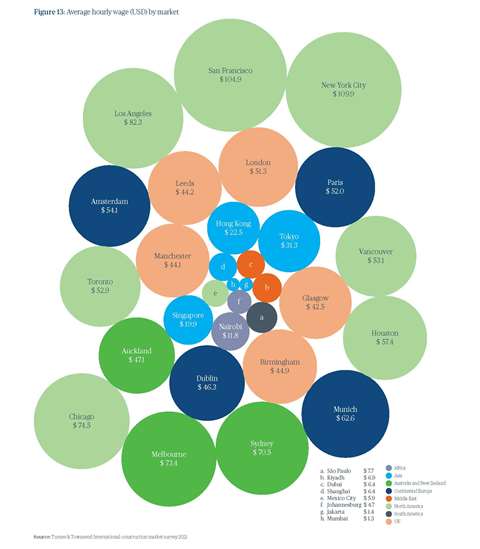How to solve construction’s skills shortage
18 February 2022
Demand for new infrastructure across the world means a higher demand for labour but the skills shortage makes this increasingly difficult, writes Catrin Jones.
Whilst the world continues to recover from the impact of the Covid-19 pandemic, the construction industry is busy preparing projects and designing new infrastructure for the coming year and decades ahead. From road building to bridges, there is a lot planned for 2022 and beyond, but is there sufficient labour to fulfil these projects?
The 2021 Turner and Townsend’s international construction market survey reported that, whilst activity is increasing in the industry after a tumultuous couple of years, supply chain issues and an increasing skills shortage are worsening – resulting in construction cost inflation in multiple markets. The report states that among the 90 participating markets, 64% were facing a skills shortage last year – this included cities such as Montreal, Seoul, Hong Kong, Chicago, and Perth.
 As the skills shortage gets worse, the average wage for workers will increase as their skills become more in demand. Image from The 2021 Turner and Townsend international construction market survey
As the skills shortage gets worse, the average wage for workers will increase as their skills become more in demand. Image from The 2021 Turner and Townsend international construction market survey
It should be noted that this worker shortage is not felt the same across the world. Markets that indicated there was a surplus of labour were mostly in Africa and South America, where these
region’s pipelines of construction work have been heavily impacted by the pandemic. Still, according to the report, only 10% of the industry has a skills ‘surplus’.
A growing number of countries rely on migrant workers, but international border closures have meant that imported labour has been significantly limited or unavailable. At the start of the pandemic, many migrants returned home from their region of work; a large number have not returned. This has exacerbated existing problems with a shortage of workers. In short, migration, which is often perceived as a solution to these shortages, can no longer be relied upon to fill a growing skills gap.
Australia has been particularly impacted by this, with the country having a very strict border policy. Major public infrastructure activity is planned in Australia across transport, utilities, and buildings with annual infrastructure expenditure planned to double by 2023 to AUD$54 billion, according to Infrastructure Australia’s infrastructure market capacity report. Therefore, a skilled workforce that is available when required will be imperative to bring these plans to fruition.
Could technology solve construction skills shortages?
Cameron Clark, earthmoving industry director at Trimble Civil Infrastructure Solutions believes that technology can help solve the skills shortage in the construction industry in two key ways: first, by helping today’s construction workers do their jobs better, faster and safer; and second by helping attract new workers to jobs in construction.
 Cameron Clark, earthmoving industry director at Trimble Civil Infrastructure Solutions.
Cameron Clark, earthmoving industry director at Trimble Civil Infrastructure Solutions.
“At Trimble, we are focused on developing technology that can dramatically increase the productivity of lesser-skilled workers, for example through operator assistance features. This helps overcome the challenge of there being fewer and fewer highly experienced machine operators in the workforce and has the added benefit of making new operators feel proud and confident in what they can accomplish with advanced technology,” he comments.
He adds that, for the generation of workers entering the construction industry now – and in the future – technology is not new, or scary. It is simply a way of life. “The next generation of construction workers are digital natives. They grew up playing video games and using handheld devices as part of their daily lives, and they are absolutely looking for jobs with contractors who are investing in modern technology,” he comments.
“We have customers who are relying heavily on technology to grow their companies – by hiring young workers who are excited about automation, robotics, augmented reality, and other advanced technologies, and then using the benefits of their growing team to take on more and new types of projects.”
While technology is undoubtably a key part of construction’s armoury in attracting new workers, it is also vital that the industry retains the workers it currently has.
Edwin Winton, director at Lawsons Recruitment, says that to prevent losing potential workers to other sectors employers themselves need to make changes, “It is important to look again at the Employee Value Propositions, packages, leave, working hours and conditions. Internal development is crucial if companies wish to retain talent – are the opportunities, the support, and the pathways in place to allow people to develop and progress within an organisation?
“From a recruitment perspective, there will be increasing competition for talent. Candidates have far more choices and opportunities than ever before. They are also becoming more discerning, and expectations are changing.”
How to manage ageing in the workforce
The construction industry is beginning to see the real impact of the ageing workforce as baby boomers retire. Educating younger generations on the benefits of a career in construction is essential, as is providing them with the necessary training opportunities. Winton added that, ultimately, greater vocational education and improved pathways are needed in the long term.
 The right training is essential in ensuring workers stay engaged in their work and don’t leave for another industry .
The right training is essential in ensuring workers stay engaged in their work and don’t leave for another industry .
Raj Somal, director at Dice, a multi-disciplinary engineering consultancy based in the UK, believes the key to attracting future generations is aligning with their sustainable values and promoting an inclusive culture.
“We firmly believe that bridging the skills gap is all about attracting future engineers and engaging with them,” he comments. “A recent report found that the majority (62%) of Gen Z are aware and engaged with the climate emergency, but only one in three see the construction industry as a sector they can work in to address it – despite the built environment contributing 40% of the UK’s carbon footprint. Therefore, focusing on sustainability to create green-skilled jobs must be a priority.”
Which construction skills are in demand?
To encourage more young people to join the industry, companies should recognise the importance of offering the right training and development opportunities. In the UK a five-level qualification on the Future of Construction has been created, which allows an individual to ‘futureproof’ themselves and to help the industry provide an individual with a life of careers within construction.
The Future of Construction initiative is led by national framework provider Pagabo and made up of representatives from across the wider construction industry, who collaborate to create the future workplace.
Charley Wainwright, who was hired in 2020 to lead on the Future of Construction initiative, has been driving this area of work for Pagabo, said, “We have to make sure that the skills gap we are facing doesn’t get any bigger, and that training is fit for the new practices that digital transformation will bring.
“This latest data demonstrates that squeeze on skills in the sector further, so it’s more important than ever that we are getting the best talent into the industry – but most crucially, they are trained with the skills the future will need.”
Construction and the skills shortage
The skills shortage is certainly being felt keenly in Europe and CECE, an industry body that represents the interests of national construction equipment manufacturer associations in Europe, says they are also determined to address the skills gap by developing solutions together with its partners.
Demographic change, too few women on job sites, lack of engineers, fierce competition, little interest in STEM (science, technology, engineering, and mathematics) disciplines and growing demand for digital skills are the biggest challenges in the construction and equipment sectors at present.
 Charley Wainwright was hired by Pagabo to lead on the Future of Construction initiative, aimed at attracting new workers into construction
Charley Wainwright was hired by Pagabo to lead on the Future of Construction initiative, aimed at attracting new workers into construction
Roma Guziak, communications manager at CECE, says, “This requires a strategic and collective approach from key stakeholders in and around the construction and equipment industries. Working together across the full construction value chain towards the betterment of the construction industry’s image will aim to attract young talents to the sector, close the skills gap, and tackle the digitisation issue of the construction industry.
“The education sector and young people need to reconsider the value of technical, professional and manual training as a gateway to successful and well-paid jobs, most of all in countries hit by youth unemployment. There is no better way to do that than by showcasing the excellence of young people in some of these trades and letting youngsters try those trades,” says Guziak.
The shortage of a skilled workforce in the construction equipment sector is one of the issues that CECE say they are continuously addressing by promoting Europe’s construction sector to young people as an attractive career choice.
Guziak adds that, “There are various skills initiatives, such as the British ‘Primary Engineer’ which is mainly focusing on training primary school teachers, the German ‘Think BIG!’ project or the ‘Boss Ladies’ project that aims to help women entrepreneurs.”
Making construction a good career
Sustainability, robot dogs, and new technologies for training and education are rapidly changing the image of the construction sector, which is sometimes still perceived as physically challenging, dirty, or dangerous.
Somal at Dice agrees that technology could be the key to the future of construction and whilst it has been seen as a traditional industry for some time, advances in technology are beginning to change this outdated perception.
“The sector is very modern and creative, so I like to think that [Dice] are part of a new generation of engineers who are using tech to innovate and deliver projects more sustainably and efficiently,” he comments.
“We work with tools like REVIT to generate 3D models of buildings, and all our technical mark-ups are carried out on iPads, tying in with our aim to be a paperless business. Our engineers utilise collaborative processes such as BIM (Building Information Modelling) to help us remain technology-forward.”
Requirements for digital and data services have surged, according to the Turner and Townsend survey, particularly e-commerce. This is fuelling demand for new data centres and distribution facilities. The survey states that data centres made it into the top five performing construction sectors, this is driven by the unabated growth in technology and digitalisation.
 Businesses are being urged to examine the employee benefits they offer in a bid to help attract new workers and retain existing ones.
Businesses are being urged to examine the employee benefits they offer in a bid to help attract new workers and retain existing ones.
As Trimble’s Clark says, “We work closely with colleges, universities, trade schools, and unions around the world to expose students to hands-on experience with technology that is transforming the industry. For example, we have collaborated with more than 25 colleges and universities in 14 countries to establish state-of-the-art Trimble Technology Labs on college campuses.
“Trimble Technology Labs provide students with hands-on experience with a wide breadth of Trimble solutions, including in construction management, constructible building information modelling, automated construction, mixed reality applications, and much more.”
Whilst there is no single quick-fix solution to the skills shortage, technological innovation is demonstrating its benefits to drive construction into the future and is the key to recruiting a new workforce.
How many women work in the construction industry?Women are under-represented in the construction industry: before the pandemic, McKinsey estimated that women make up just 12% of the global construction industry – around 8% in the EU, 10% in the US, 11% in the UK, 12% in Australia and 13% in Canada. With the industry suffering a shortage of workers, attracting more women into construction could be one way of addressing this. The global Coivd-19 pandemic has changed working patterns around the world, and may have already attracted more women into construction. In an interview with KHL’s Lucy Barnard, Holly Price, a director at construction engineering firm Keltbray commented that, “I would argue that the pandemic is a golden opportunity to re-balance the construction industry as a whole,” she said. Figures from the Bureau of Labor Statistics (BLS) and analysed by thinktank Institute for Women’s Policy Research (IWPR), show that although women in the US made a collective net loss of more than 3 million jobs between February 2020 and September 2021, the construction sector was one of the very few industries where the number of jobs held by women over that period increased by 300,000. “This current trend is genuinely new,” says Ariane Hegewisch who leads the Employment & Earnings programme at the IWPR. “In previous downturns women lost more jobs than men in the sector but this time women actually increased their share of jobs.” |
STAY CONNECTED



Receive the information you need when you need it through our world-leading magazines, newsletters and daily briefings.
CONNECT WITH THE TEAM







